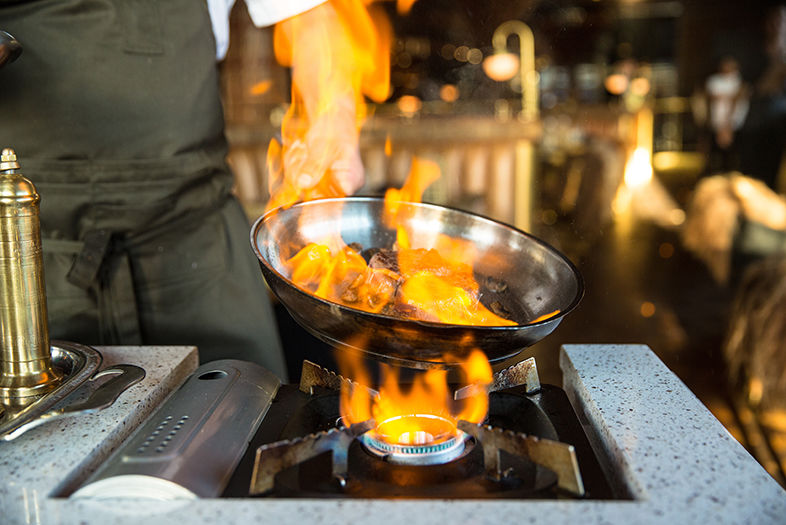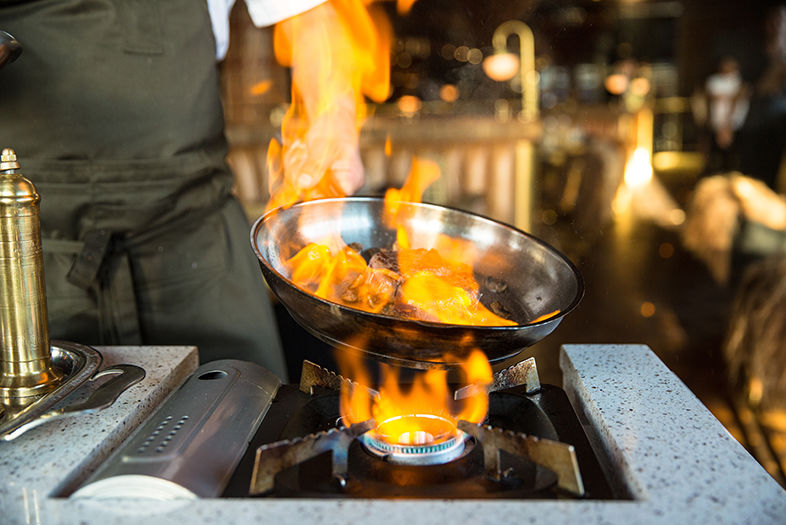In mid-century New York, tableside flambéing was a very big deal. The server would roll out an elaborate cart, set a dish on fire to the amusement of his diners, and finish the dish before their eyes. Baked Alaska. Crepes Suzette. Chateaubriand. Cherries jubilee. Bananas Foster. Food and fire and heat and danger.
Tableside presentation was dinner and a show. But where did it go? It was all but abandoned in the 1980s along with disco. Was it just an old trick that, like the circus or fireworks, have lost a little magic as entertainment has evolved?
The practice has French roots. In the early 1900s America, servers at high-end restaurants were only assigned one single table a night. One table. They would lurk nearby at attention to make sure you had everything you needed. The server would choose which cut of meat you were served, they’d select your produce—they controlled it all. But when restaurants started courting the middle-class, this elaborate magic show wasn’t cost-effective. The entire meal was assembled on a plate in the kitchen and sent out.
To stand out and earn their tips, servers started doing the little things tableside—grinding fresh pepper, setting crepes Suzette on fire. Tableside presentations were also big in the early 1900s because adulterated food was a big scandal—milk thinned with water, chalk mixed into flour, charcoal in pepper. So tableside was a way to win the customer’s trust and faith in a dubious food age.
When restaurants started building open kitchens, there was less of a need. You could see the fire, the knives, the chefs. Plus, lots of cities didn’t view freestyle fire shows as terribly safe, and wrote fire codes to prevent table side flambé.
And now it’s back in San Diego in a grand way at Born & Raised, the $6.5 million steakhouse in Little Italy from Consortium Holdings, the same people who brought us Craft & Commerce, Ironside, Underbelly, Soda & Swine, Neighborhood, Noble Experiment, Polite Provisions, etc. In the day and age of fast-casual and human servers being replaced with kiosks, they’ve revived the old art.
Here’s what they’re offering, with a little insight into what makes each dish so special:
Steak Diane
Diane is the Roman goddess of the hunt, and she’s name-checked in a lot of game-related dishes. This pan-fried steak is pretty similar to a steak au poivre (pepper steak). Usually a tenderloin is cut thin or pounded thin so that it’ll cook fast. The sauce is usually made with pan drippings, butter, mushrooms, shallots, stock, Worcestershire. When flambeed, the sauce concentrates and caramelizes, intensifying the flavor. Most people give credit to the Drake Hotel, where it was first mentioned in 1949.
Caesar Salad
This salad was, yes, invented in Tijuana by Italian chef Caesar Cardini. Cardini lived in San Diego, but worked in TJ because Prohibition was sucking the fun out of life. A Fourth of July rush in 1924 meant they were low on food. So Cardini tossed what he had—lettuce, Parmesan, lemon juice, pepper, garlic, olive oil, Worcestershire sauce, croutons, and vinegar. Legend was born.
Worcestershire Sauce
You’ll notice a common ingredient in a few of these recipes: Worcestershire. What makes Worcestershire so good? Anchovies. It was created by a couple of chemists in Worcester, England. Originally, they thought it tasted pretty bad. But they let it sit for a few months and found the flavors had mellowed out. It’s essentially fermented and aged fish sauce, which is what makes so many Asian dishes pop with flavor. The ancient Romans had a version of this sauce, too, called garum. The usual recipe for Worcestershire is barley malt vinegar, spirit vinegar, molasses, sugar, salt, anchovies, tamarind extract, onions, garlic, spice, then probably soy sauce, lemons, pickles, and peppers. It’s the oldest commercially bottled condiment int the U.S. Fermented foods, as we know, are the best (coffee, cheese, yogurt, chocolate, wine, beer, vanilla, vinegar, miso, etc.).
Shrimp Louie
Another west coast classic, invented either in San Francisco or Seattle, depending on which creation story you believe. Again, Worcestershire is a key ingredient, along with mayo, chile sauce, ketchup, relish, and hot sauce.
Steak Tartare
Yep. Finely chopped, or ground meat. In France, it’s often made with horse meat. Usually served with onions, capers, seasonings (fresh ground pepper and Worcestershire), raw egg yolk, and rye bread. It was originally served with tartar sauce. Also known as the cannibal sandwich. Meat sushi. Usually made with eye of round or tenderloin. When ordering, always remember that raw meat should be red, not brown.
Omelette
The classic French omelette is considered a true test of a chef. It was first introduced to America by Dione Lucas at the New York restaurant The Gingerman. Smooth, silky exterior with little to no browning. Done correctly, the inside should be a moist-soft scramble. Has to be cooked over moderate heat to let you do it just right. You’ve got to add the eggs to the pan and stir really fast with a fork, shaking the pan to agitate the eggs. Cook for one to two minutes. We all think of American omelettes as these big, half-moon, overstuffed and overcooked things. Brown on the outside. Smells like sulfur. The French omelette, in comparison, is a delicate, silky thing. The French refer to it as baveuse, which means runny. A lot of chefs will actually use a plastic fork. High heat allows the egg to set before it bonds with the metal. You want the interior creamy. When it comes to fillings, French omelettes are different. You slice the top of the omelette lengthwise, open it up, and then load in your fillings.
1909 India Street, Little Italy, 619-202-4577

Dinner and a Show: Born & Raised Brings Back Tableside Dining
Steak Diane being prepared tableside at Born & Raised. | Photo: Sam Wells


















